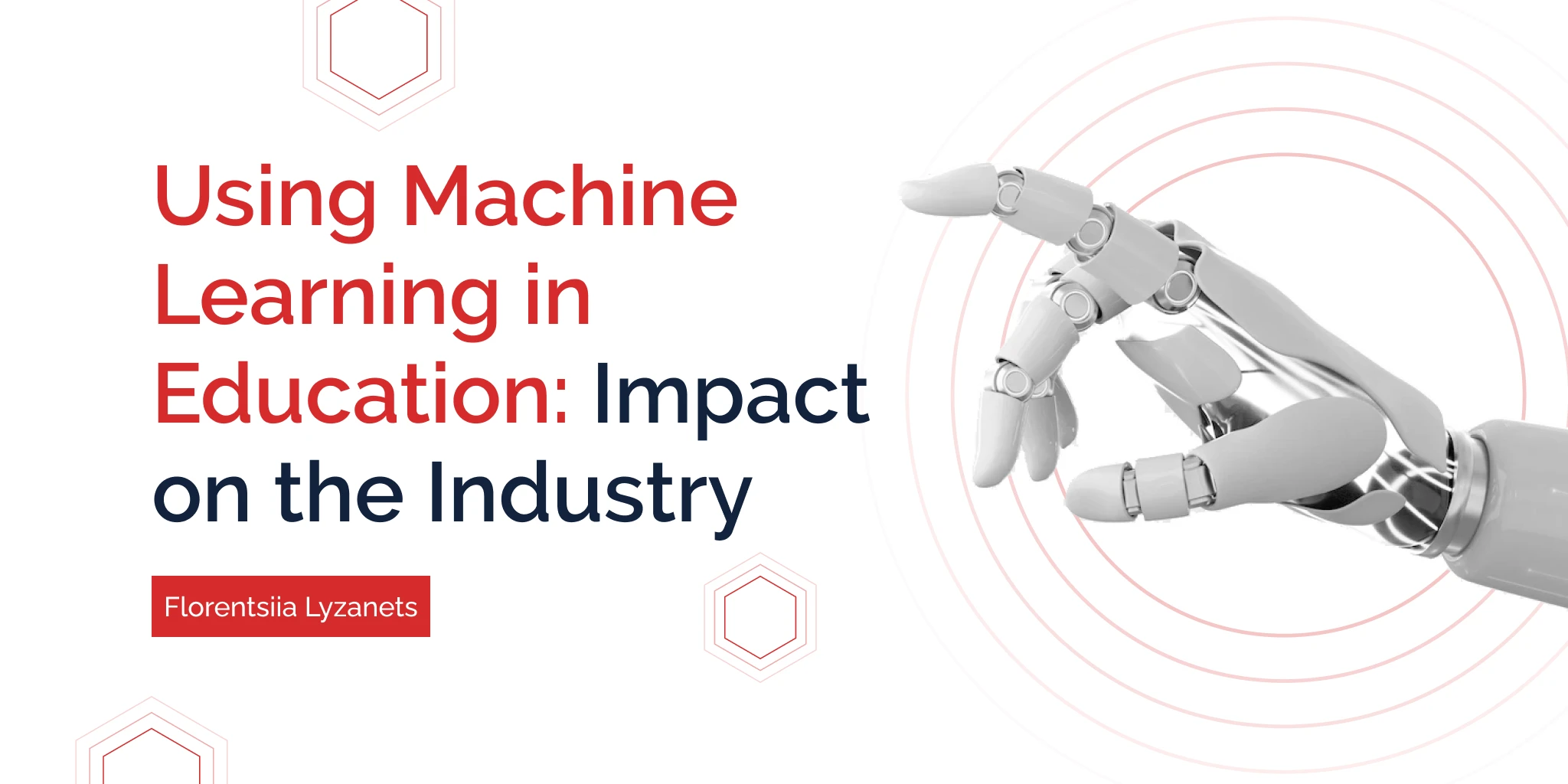Education can do wonders in every aspect of our lives. However, knowing about machine learning in education and applying it might be far more advantageous. Success is guaranteed.
In this article, we’ll explore how the wise application of this technology can help maximize your institution’s effectiveness. Are there any challenges in machine learning or only benefits? What is the role of machine learning in the education sector today, and what is the future perspective of ML? We’ve also compiled a list of ML examples, based on which you can see that the use cases for the technology are very different. I hope you’re interested in the answers to at least one of these questions. Well, let’s move on to the topic.
Role of Machine Learning in Education
We have been using computers for many years to simplify most educational processes. Machine learning is one of the widespread and efficient tools; as a result, we can see the positive outcome of using machine learning in education today.
Teaching, learning, and research methodologies are being transformed and changed fundamentally by ML. So, why and how machine learning can be used in education is a valid question. Let’s examine a few examples.
- One of the known applications of the technology is to spot students with learning difficulties and enhance their performance and retention in class.
Through adaptive learning, it analyzes students’ performance in real-time and changes teaching methods based on the research. As a result, the learning path is more personalized and thus adapted to every individual for a better education.
- ML increases the quality and efficiency of the teaching-learning process.
It facilitates the effective management of educational schedules and content based on the capacities and needs of each student. By allowing educators to complete tasks like classroom management and scheduling, they can focus more on assignments requiring rather human involvement than AI.
- Machine Learning provides predictive analytics in the educational process.
Thanks to its usage, educators can appropriately estimate the needs and mindset of the students and get alert as necessary. With techniques and tools of predictive analytics, educators can see what may happen based on present and past data. Apart from this, the analytics offers the students paths they should take. With the help of this software, they can receive guidance on educational resources and other learning procedures.
How Is Machine Learning Different from Artificial Intelligence?
We often hear about machine learning, artificial intelligence, big data, and deep learning, which are very common. Although they’re connected, some features figure them out and show us what they’re and how they differ. We’ll mainly focus on machine learning and artificial intelligence since these terms are relevant to our topic.
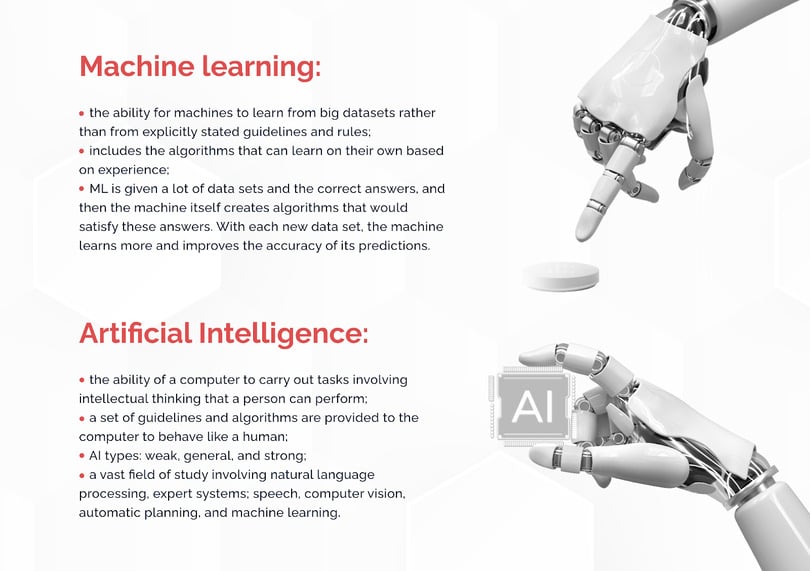
While artificial intelligence is a broad industry covering machine learning and deep learning, machine learning is a type of artificial intelligence.
AI describes the ability of a computer to carry out tasks that a person can perform. These aren’t just some mechanical actions like picking up, bringing, or carrying something. These are the tasks involving intellectual thinking to make a practical decision, such as recognizing what is shown in the picture or how to win chess. For this, a set of guidelines and algorithms are provided to the computer to behave like a human.
AI can be of three types: weak, general, and strong. Weak AI is when a machine can handle a limited number of tasks. General AI can solve an intellectual problem as well as a human. A strong AI can cope with most tasks far better than a human.
As we’ve mentioned already, AI is a vast field of study, which includes:
- natural language processing (translating texts, transcribing texts, or compiling complex texts by computers);
- expert systems simulating the ability of a person to make a decision (using if-then rules);
- speech (the computer must recognize the human speech and be able to speak itself);
- computer vision (the ability to identify specific objects and images);
- automatic planning (for performing sequential actions);
- finally, machine learning.
The need for machine learning in the education industry emerged when we wanted to teach the computer more instructions to make them wiser. It wasn’t that simple, though. It took us a lot of effort since we couldn’t develop a guideline for every situation. Then the scientists decided to create algorithms that could learn on their own based on experience. Accordingly, machine learning entails the ability for machines to learn from big datasets rather than from explicitly stated guidelines and rules. Machine learning in education research is how we train an algorithm to make it more effective and accurate. In other words, we give a lot of data sets and the correct answers, and then the machine itself creates algorithms that would satisfy these answers. With each new data set, the machine learns more and improves the accuracy of its predictions.
To compare AI with machine learning practically, let’s use the game of chess as an example. While for AI, we’ll give logical rules and instructions for machine learning, for ML, we’ll provide many examples of games that the machine will study and analyze. Then, it creates its algorithms when the players lose or win and make the rules of what to do to win.
Benefits of Applying Machine Learning in Education
Machine learning is an innovative and powerful educational tool, growing fast and making a difference for educators and learners.
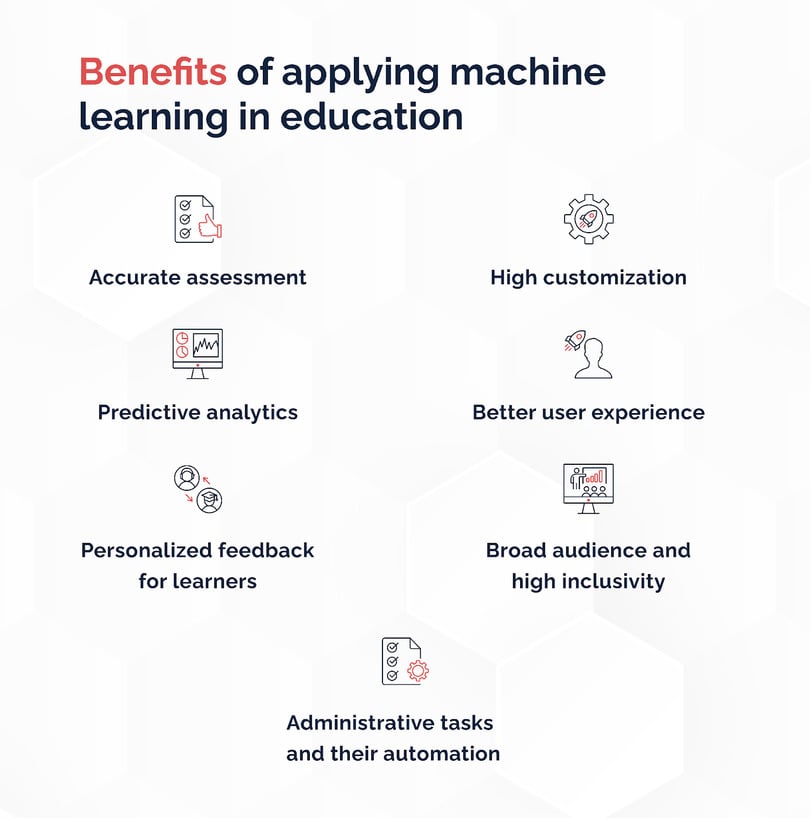
Let’s view the list of the top benefits of machine learning in education.
Accurate assessment
Educational experts sometimes report the biased grading system in educational institutions. This is because the educators can consider other factors unrelated to students’ knowledge.
As a result, professionals in the educational sector believe ML and AI can significantly contribute to developing a more accurate assessment system. In China, about 60 thousand schools are testing a paper grading system allowing them to evaluate students’ essays automatically. It’s beneficial, particularly given that educators can sometimes focus on non-fundamental factors, like overall academic performance in classes or physical presence. Instead, the system estimates the essay’s style, structure, and content.
High customization
Today, using machine learning in education gives everyone the chance to have a top-notch learning experience, regardless of how pricey or even free the product is. That’s the unique idea behind modern innovations. When it comes to creating online classes and courses for the educational industry, machine learning can be at everyone’s needs. It aids in developing customized class adjustments, identifying learners’ areas of weakness, and modifying the pace of education following the requirements and level of the student. It’s an excellent engine for progress, allowing you to access virtual assistants, complete smooth onboarding, receive interesting customized programs, and take your learning to a new level. There is little chance that pupils would lose interest when machine learning is used in the classroom. ML and AI, on the other hand, help to increase retention rates throughout the learning process.
Predictive analytics
ML is beneficial in education since it can foresee the students’ behavior and determine their intentions and triggers, stimulating specific actions. The educators value this information since they can prevent a critical issue before it may occur. They can see the students’ intention to drop the class, the reason for learners’ demotivation, or get information concerning the customer’s wish to complete another course.
Better user experience
The completion of monotonous tasks is something machines accomplish better than humans. Scheduling, tracking attendance, and managing assignments relate to this work. Machine learning saves educators’ time, relieve them from most difficulties, and leaves the target users with exciting parts. Mistakes are practically inevitable, but machine learning helps to prevent them effectively.
Personalized feedback for learners
Educators can’t follow every student in more extensive online courses and provide them with relevant feedback. However, machine learning is going to solve it. The technology can track the students’ progress and deliver reviews based on their performance throughout the course. It can increase the learners’ motivation, understand their learning path, and succeed in their studies. Besides, machine learning can answer any question the learners can have. Still, this level of assistance needs to be improved to respond to learners’ queries using natural language processing.
Broad audience and high inclusivity
Today, the biggest e-learning platforms with dozens of content aren’t a problem. Machine learning can provide high-quality translation and transcription, thus, increasing the user base. The business owner shouldn’t spend much money on pricey consultants to make the instructional materials available to everyone. ML and AI operate faster and at a reasonable price without sacrificing quality. In addition, ML can deliver content in various ways like text, audio, video, and presentation to involve people with disabilities in the educational process.
Administrative tasks and their automation
Machine learning takes over time-consuming regular operations like providing course instructions, planning curriculum, sharing course material, and dealing with tons of paperwork and materials. It enables instructors to produce more valuable content and spend more time providing high-quality teaching.
Machine learning in education: Examples
What is the best way to show the value and efficiency of machine learning and education? Right, real-world machine learning examples in education. So, let’s look at several success stories in education where the tool is efficiently applied.
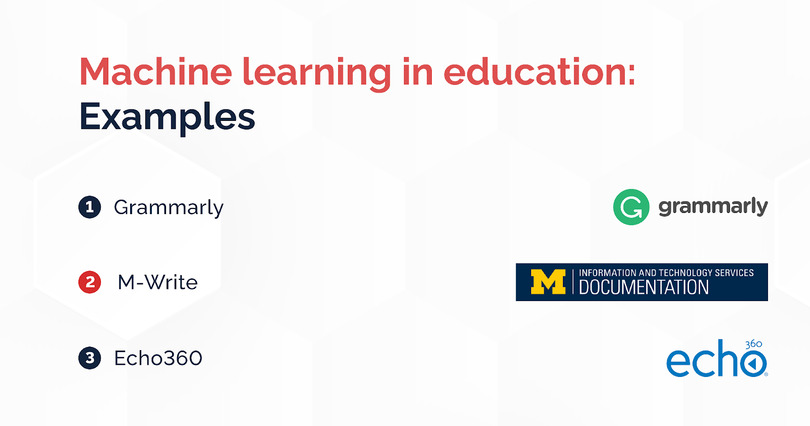
#1. Grammarly
Grammarly is a helpful virtual assistant combining language processing, machine, and deep learning. The tool is widely valuable among users allowing them to efficiently check spelling, grammar, and punctuation and suggests changes to the general manner of the text and its delivery. The algorithms in Grammarly are trained to take the users’ behavior and actions into account. For instance, if more users reject a suggestion or mark it as a mistake, the machine learning algorithm will study, analyze, and train itself. What’s more, another benefit of Grammarly is its capacity to check the text for plagiarism. It’s an excellent alternative for the user, allowing them to save time. The user can get instant results concerning the originality of their text compared to other texts in the databases.
#2. M-Write
Usually, multiple-choice tests used by universities may be used more often to assess students since they take less time. However, practice shows that students with well-developed intuition can get higher results than students who are better at subjects but view some answers as subjective. When completing such quizzes, some students may doubt the answers by thinking over several scenarios to some test questions. However, the question is if they’re appropriate methods for grading the students?
M-Write is a tool the University of Michigan applies as part of its writing-to-learn pedagogy. It’s an automated text analysis tool containing machine learning algorithms to advance students’ writing. The initial idea behind M-Write is based on the assumption that student-completed writing assignments on specific courses or subjects are more effective than multiple-choice assessments. Written assignments give teachers more precise grading because it’s much easier to assess students’ actual knowledge and identify those who have learning disabilities.
The development team of the tool used the data from students previously involved in the program. Utilizing the data, the team develops and trains algorithms to recognize pupils with varying levels of knowledge. To analyze written texts by students, the tool’s machine learning algorithms apply diverse methods like matching the vocabulary or the topic. In-built prompts of the program allow for the differentiation between weak and strong answers. The peer review feature of M-Write is an additional advantage. Students can upload their written assignments, give feedback to the responses of other peers, and get reviews on their writing.
#3. Echo360
Today, learners have different backgrounds and needs in education. For this reason, it’s critical to design tools with the proper flexibility and accessibility for everyone to meet the requirements of each learner. Echo360 uses AWS to promote the strength of machine learning in online education. This learning platform employs analytics to anticipate the amount of student engagement in the course. This way, it personalizes the content and gives students the most engaging and worthwhile learning experience possible.
For learners to get smarter searches and access the content more effectively, the platform uses Amazon Transcribe’s automatic speech recognition technology. What’s more, Echo360 is tailored to meet the demands of individual students. Individuals with hearing difficulties or studying the course while riding the bus to work can use the platform without relying on audio. The tool provides effective, closed captioning for all educational video materials. Besides, students can review transcriptions of videos and copy the exciting and essential lecture parts in their notes. It’s advantageous for the students who can’t record their notes while listening to or viewing the lecture.
Main Challenges of Machine Learning in Education
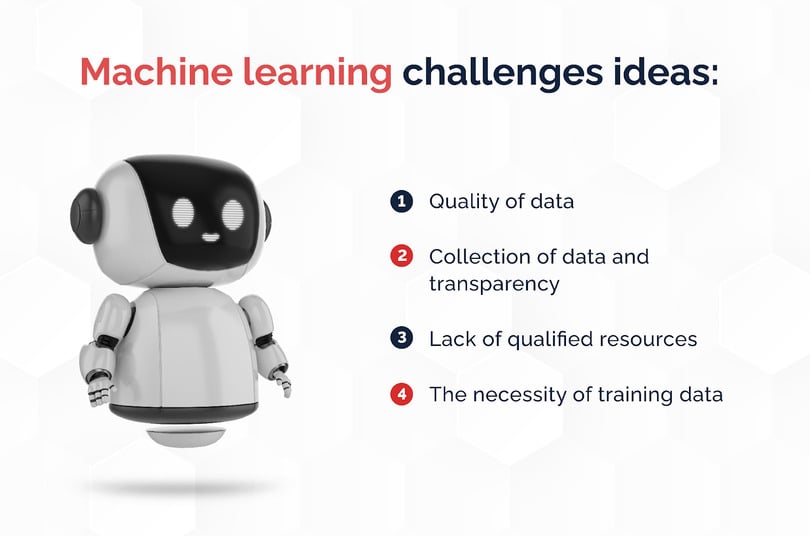
If applied properly, machine learning and artificial intelligence can benefit education. No matter how advanced technology is, we should utilize it cautiously to avoid data leaks, safeguard data privacy, and promote transparency in all processes.
Quality of data
Poor data quality can lead to inaccurate or faulty algorithm predictions. Improving algorithms is often time-consuming, and data quality influences how the algorithms function. Therefore, you shouldn’t compromise data quality to save time. The right solution is to make the data preprocessing process of the utmost perfection. To achieve a high quality of data, we should appropriately assess and analyze the data, eliminate undesirable features, and filter out missing values.
Collection of data and transparency
Unprotected privacy is still a hot concern in terms of the use of machine learning. Everyone, including parents, students, and teachers, must understand it. The topical question is how ML collects the data and who can access it. Consequently, before applying machine learning in education, educators should run a more thorough analysis to secure the confidentiality of everyone involved in teaching and learning.
Lack of qualified resources
Although there is enough information about machine learning, which continues to be widely used, it’s still a relatively new technology. There is a shortage of qualified specialists to handle deep analytics. It’s costly enough since employees with in-depth expertise in their domain and specific science know their worth.
The necessity of training data
Similar to how we teach kids to learn new information and distinguish between different objects, we should develop an efficient machine learning model. In terms of data, we must ensure it’s sufficient for the model to accomplish various assignments. While fewer examples are required for a baby to distinguish between a cat and a dog, it’s insufficient for machine learning. Our prime task is to make the ML work like a genius so that it can classify objects by shapes, colors, and other characteristics. In turn, completing a simple task requires thousands of samples, whereas complex tasks such as object classification or speech recognition may take more than millions of samples. Since using the incorrect model or data can result in mistakes, we must provide the model with enough information for processing.
The Future of Machine Learning in the Education Sector
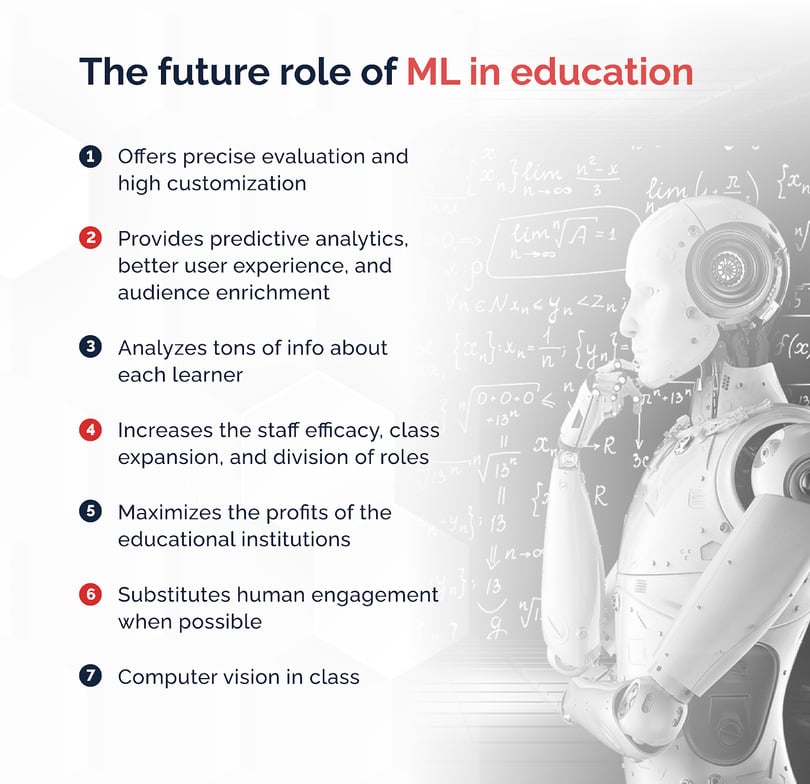
The future role of machine learning in education is essential and well-promising. It revolutionizes and transforms the sector by offering precise evaluation, high customization, predictive analytics, better user experience, and audience enrichment. It enables educators to keep pupils engaged without exerting too much control over their learning behavior.
When the classrooms are full of students, it may become difficult for educators to control some processes, like the size of the facility. Instead, ML can be used to analyze tons of info about each child, thus increasing the staff efficacy, class expansion, and division of roles. In this scenario, everyone can get the benefit. The educational institution can involve more students, thus maximizing profits. The educators can cooperate better and share their tasks, experience, and vision when focusing on the class size, students’ knowledge, and learning needs.
Another application of machine learning in class we can face today. When possible, it effectively and even better substitutes human engagement. Machine learning can perfectly handle routine and monotonous operations like checking the student’s presence in class. We can promote the idea of computer vision in class. Namely, we can train algorithms to study and analyze security footage and assign particular names to specific students. It can help to check the students’ attendance, thus saving educators time and enabling them to concentrate more on the subject and critical tasks.
You can approach tech specialists with a precise and original vision of the technology helping you make the future operations in your organization promising. If to implement machine learning innovatively, it can simplify many things in your business, allowing you have potent perspectives.
Summary
Machine learning in the education sector isn’t a magic fix. Consequently, I won’t convince you to spend thousands of dollars implementing this tool for your company. However, we don’t have to be prophets to understand that ML models will become more accurate, ML applications will be more beneficial and innovative, and fewer challenges will be present throughout the use of the technology.
Not long ago, many technologies weren’t as popular and promising as they’re now. For this, we may assume ML can open up new possibilities in ed tech in upcoming years by modifying our traditional teaching and learning methods.
FAQ
How can one apply machine learning to education?
Machine learning in education can be applied in multiple ways, just like, for example, some form of cloud-based learning management system. Firstly, you can try to create full-scale recommendation systems for the students. Using them, you’ll be able to personalize content according to some internal learning methodologies. Secondly, a strong idea is to have warning systems that can identify moments when students or even whole education institutions are failing. Thirdly, machine learning is a potent technology for automatic grading. These tools can make full-scale judgments on student progress by analyzing a myriad of factors regarding them. Ultimately, there are also many other uses: you can use those systems to detect plagiarism via access to some online source, or, for example, provide some interesting gamification options.
What are the core reasons for using machine learning in the education sector?
The core reasons for using machine learning in the education sector are diverse. In this regard, the core factor that pushes education institutions to use a combination of machine learning with traditional methods is undoubtedly the ability to save time. Modern machine learning tools have capabilities to analyze tremendous amounts of information that were unavailable to teachers in the past. As mentioned above, they can also boost your ability to grade students quickly by automating progress checking.
And, what are some other reasons to consider this technology? Above all, it has the capability to improve school operation processes by highlighting teacher biases. If you’re unsure about your choices regarding student performance, AI may be a perfect enhancement for your analytics. Besides, this technology also enables personalization for students and prevents issues such as plagiarism.
What’s the positive impact of machine learning on schools?
In our opinion, the impact of machine learning on schools is positive in many dimensions. Primarily, machine learning saves time for its core target audience, teachers. In one way or another, they get tools that prevent biases and, more importantly, provide opportunities to save time.
Moreover, this educational technology is notable for its ability to create a better e-learning environment. Machine tools have enough processing power to enable personalization and even track individual students to prevent large-scale problems with their education. In this respect, machine learning pushes us towards the future of education by enabling a solution that makes the skills development process unique for every student.
How do machine learning and AI differ?
ML in education is a complex field to a great extent because the term itself is highly complex. When choosing machine learning development services, it’s essential to understand what this sector stands for. Ultimately, AI is a tool that can perform a typically human task. This approach includes a broad range of techniques, which can include a blend of machine learning with other frameworks such as neural networks. In turn, machine learning refers to the specific technique of creating algorithms that can perform tasks without explicit coding. Thus, ML in education isn’t about AI alone, as one may think: it refers to a specific technique of algorithm creation. In this regard, the core advantages of machine learning are that it requires fewer resources to create than a full-scale AI. AI is typically a much more complex technology that unifies multiple dimensions.
You can contact Keenethics if you have a machine learning idea, another business goal, or want to learn more about the application of ML. We’re here to hear you out.

